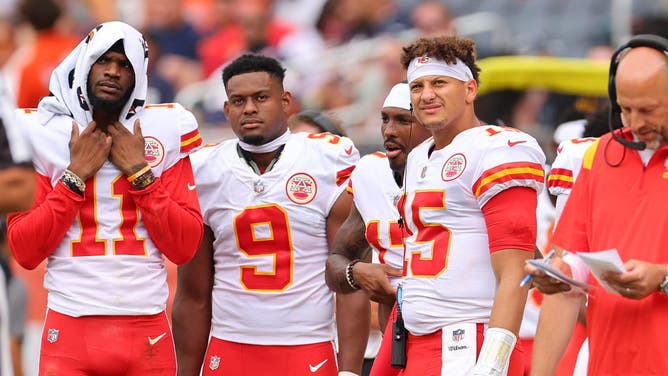Premium NFL Wide Receivers Can Be Inexpensive, Despite What Agent Tells ESPN
ESPN’s Dan Graziano this week traced an exploding market for the top-paid NFL wide receivers. Equally fascinating is the flip side of that story.
The Pittsburgh Steelers haven’t traded for a receiver since 2003, haven’t drafted one in the first round since 2006, and haven’t overpaid one in forever. Instead, in 11 of the past 15 years, they’ve taken a second- or third-round WR.
This year’s bargain is George Pickens, the league-wide rookie sensation of training camp, chosen 52nd overall in the second round. Pickens combines with Chase Claypool (second round, 2020) and Diontae Johnson (third round, 2019) to give the Steelers a top-5 threesome. They fill out their WR room with fourth-round rookie Calvin Austin III and inexpensive veterans Gunner Olszewski and Miles Boykin. Aggregate cap charge for all six: $15 million.

Pittsburgh avoids the risky $20 million-plus receiver with this philosophy: Wide-open college offenses are producing NFL-ready receivers at a staggering rate. Nothing is more cost-efficient than starters playing on rookie contracts. Keep drafting them, keep churning, don’t fall in love with them. Outstanding quality at great prices is available every draft in Rounds 2 and 3.
Not Just The Steelers
What NFL clubs agree? Indianapolis QB Matt Ryan is growing comfortable with three second-round receivers: Parris Campbell (2019), Michael Pittman Jr. (2020) and Alec Pierce (2022). Aggregate cap charge for the Colts’ WR room: $9.4 million.
After trading Marquise “Hollywood” Brown, Baltimore heard the pundits’ cries to sign a veteran receiver. GM Eric DeCosta declined, bringing to camp a dozen receivers, all of them age 25 or younger. The group is led by Rashod Bateman (first round, 2021), Devin Duvernay (second round, 2020) and James Proche II (sixth round, 2020). Aggregate cap charge for the Ravens’ WR room: $6 million.

Left to right: Marquez Valdes-Scantling (11), JuJu Smith-Schuster (9) and Patrick Mahomes. (Getty Images)
Similarly, Kansas City GM Brett Veach had decisions to make after refusing Tyreek Hill’s $30 million-per-year demand and trading him to Miami for five draft choices. Veach used one of the Dolphins’ picks on starting CB Trent McDuffie. He used another on WR Skyy Moore, who joins holdover Mecole Hardman and free agents Marquez Valdes-Scantling and Juju Smith-Schuster in a rebuilt WR room that costs only $15.4 million against the cap.
Green Bay, notorious for not having drafted a first-round receiver since 2002, is sifting among nine receivers whose aggregate cap charge is $16 million. Chicago and Atlanta, both rebuilding, will each keep their WR cap expenses under $10 million.
'Premium Position'? That's Just Agent Talk
So we have competing strategies to evaluate and enjoy in the coming season. In ESPN's story, Tory Dandy, agent for A.J. Brown, Deebo Samuel, D.K. Metcalf, Mike Williams and Chris Godwin, not surprisingly endorsed the big-ticket approach. Dandy said, “I think, honestly, it’s just become a premium position.”
The definition of “premium position” has traditionally been: players who score points and directly prevent points. By that standard, NFL wide receivers have always been a premium position.
But premium vs. non-premium may no longer be the point. In today’s NFL, the real issue is scarcity vs. surplus.
Scarce positions, if there was any doubt, were identified at the top of this year’s draft – the first seven picks were edge rushers, cornerbacks and offensive tackles. Wide receiver, flooded each year with fresh college talent, is no longer a scarce position.
Terry O’Neil is a former Executive Producer of CBS Sports and NBC Sports, and former Senior Vice President of the New Orleans Saints.